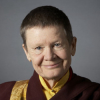Pema Chodron

Pema Chodron
Pema Chödrönis an American, Tibetan Buddhist. She is an ordained nun, acharya and disciple of Chögyam Trungpa Rinpoche. Chodron has written several books and is the director of the Gampo Abbey in Nova Scotia, Canada...
NationalityAmerican
ProfessionClergyman
Date of Birth14 July 1936
CountryUnited States of America
pain years trying
The sad part is that all we're trying to do is not feel that underlying uneasiness. The sadder part is that we proceed in such a way that the uneasiness only gets worse. The message here is that the only way to ease our pain is to experience it fully. Learn to stay. Learn to stay with uneasiness, learn to stay with the tightening, learn to stay with the itch and urge of shenpa, so that the habitual chain reaction doesn't continue to rule our lives, and the patterns that we consider unhelpful don't keep getting stronger as the days and months and years go by.
giving-up years practice
When you refrain from habitual thoughts and behavior, the uncomfortable feelings will still be there. They don’t magically disappear. Over the years, I’ve come to call resting with the discomfort “the detox period,” because when you don’t act on your habitual patterns, it’s like giving up an addiction. You’re left with the feelings you were trying to escape. The practice is to make a wholehearted relationship with that
motivational years world
How will we experience the world a month, a year, or five years from now? Will we be even angrier, more grasping and fearful, or will some shift have occurred? This depends entirely on the tendencies we reinforce today.
begins clearly closing darkness illuminate itself longer meditation shut
What's encouraging about meditation is that even if we shut down, we can no longer shut down in ignorance. We see very clearly that we're closing off. That in itself begins to illuminate the darkness of ignorance.
precious-jewels may mud
Our true nature is like a precious jewel: although it may be temporarily buried in mud, it remains completely brilliant and unaffected. We simply have to uncover it.
suffering causes happens
It isn't what happens to us that causes us to suffer; it's what we say to ourselves about what happens.
pain powerful feelings
One very powerful and effective way to work with this tendency to push away pain and hold on to pleasure is the practice of tonglen. In tonglen practice, when we see or feel suffering, we breathe in with the notion of completely feeling it, accepting it, and owning it.
pain pleasure
This is the tendency of all living things: to avoid pain and to cling to pleasure.
spiritual real healing
So many of us start along the spiritual path because we are suffering. But you must realize that for real healing to occur, there must first be deep compassion for yourself, especially the parts of yourself you dislike or consider ugly.
spiritual people world
Many people hope a spiritual practice will let them avoid what they are ashamed of. But when you hide something from yourself, you are going to project it onto your world. You continually find it in others and it becomes the source of prejudices and dogmatic views. On top of that, you feel bad about yourself, because you aren't the loving, open-minded, "spiritual" person you'd like to be.
giving attention medical
If you see a homeless person on the street, and they need food, housing, medical attention - if you can give that, do it. But at the same time, work with tonglen, because that is how you start dissolving the barrier between you and them.
wise helping loser
Tonglen dissolves your solid sense of "I'm the wise person, I'm going to help this poor, unfortunate loser."
people
Tonglen is a way for you to be with people who need you - beginning with yourself.
car feelings way
Take three conscious breaths. Just pause. Let it be a contrast to being all caught up. Let it be like popping a bubble. Let it be just a moment in time, and then go on. Maybe you are on your way to whatever you need to do for the day. You are in your car, or on the bus, or standing in line. But you can still create that gap by taking three conscious breaths and being right there with the immediacy of your experience, right there with whatever you are seeing, with whatever you are doing, with whatever you are feeling.